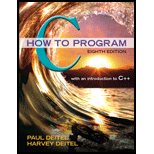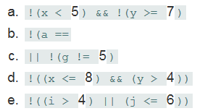
(De Morgan’s Laws)In this chapter, we discussed the logical operators &&, Ó� Ó�, and !. De Morgan’s Laws can sometimes make it more convenient for us to express a logical expression. These laws state that the expression! (condition1 && condition2) is logically equivalent to the expression (! condition 1 Ó� Ó� condition2). Also, the expression condition1 Ó� Ó� condifion2 is logically equivalent to the expression (condition1 && ! condition2). Use De Morgan’s Laws to write equivalent expressions for each of the following, and then write a

Trending nowThis is a popular solution!

Chapter 4 Solutions
C How to Program (8th Edition)
Additional Engineering Textbook Solutions
Introduction to Java Programming and Data Structures, Comprehensive Version (11th Edition)
Starting Out with Python (3rd Edition)
Starting Out with Programming Logic and Design (5th Edition) (What's New in Computer Science)
Objects First with Java: A Practical Introduction Using BlueJ (6th Edition)
Starting Out with Java: Early Objects (6th Edition)
Starting Out with Python (4th Edition)
- Define With...End With statementarrow_forward5. We are given the statement "C3PO is a droid and Han is not a droid". (a) Using the following statement variables, write the corresponding statement form: Let p = "C3PO is a droid" and q = "Han is a droid" (b) Using De Morgan's Laws, develop the negation of the statement form of part (a) (c) What is the statement that corresponds to the statement form of part (b)?arrow_forward3. Use De Morgan's Laws to write negations for the following statement: The train is late or my watch is fast.arrow_forward
- Give two examples to relational operators:arrow_forwardQuestion 9 Electrical resistors are said to be connected "in series" if the same current passes through each and "in parallel" if the same voltage is applied across each. If in series, they are equivalent to a single resistor whose resistance is given by + R₂ R = R₁ + R₂ + R3 + If in parallel, their equivalent resistance is given by 1 1 1 1 1 = + + + + R₁. R R₁ R₁ R₂ Write an M- le that prompts the user for the type of connection (series or parallel) and the number of resistors n and then computes the equivalent resistance.arrow_forwardList the operators that cannot be overloaded.arrow_forward
- . Write a negation for each of the following statements: (a) The variable S is undeclared and the data are out of order. (b) The variable S is undeclared or the data are out of order. (c) If Al was with Bob on the first, then Al is innocent. (d) −5 ≤ x < 2 (where x is a particular real number)arrow_forward4. The Area of the Target: To decide on prizes for the archery contest, you decided to use the areas of the center and rings. You decided that rings with smaller areas should be worth more points. But how much more? Complete the following investigation to help you decide. a. Find the sequence of the areas of the rings, including the center. (Be careful.) b. Write a recursive formula and an explicit formula for this sequence. C. Write the explicit formula in summation notation. Find the total area of the bull's eye if it had 9 rings around the bull's eye.arrow_forwardQuèstion 18 The order of operators and evaluation of operands are optional to understand expression evaluation. O True Falsearrow_forward
- Give a brief explanation of the idea of operator precedence.arrow_forwardModified coin-row problem:If we modified the coin-row problem, so that you cannot take the adjacent coin, and youcannot take the coin next to the adjacent coin also (see example below), what would thedynamic programming formula F(n) be?Example: A, B, C, D, E, F, G, H, I, JIf A is taken, then B & C cannot be taken, but D (or above D, like E and so on) can be taken.If B is taken, then A, C, D cannot be taken.And so on.arrow_forwardDetermine all truth value assignments, if any, for the primitive statements p,q,r,s,t that make the following compound statement false.arrow_forward
 C++ Programming: From Problem Analysis to Program...Computer ScienceISBN:9781337102087Author:D. S. MalikPublisher:Cengage LearningProgramming Logic & Design ComprehensiveComputer ScienceISBN:9781337669405Author:FARRELLPublisher:Cengage
C++ Programming: From Problem Analysis to Program...Computer ScienceISBN:9781337102087Author:D. S. MalikPublisher:Cengage LearningProgramming Logic & Design ComprehensiveComputer ScienceISBN:9781337669405Author:FARRELLPublisher:Cengage

